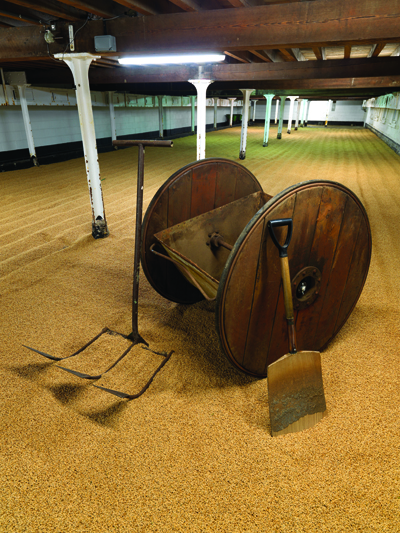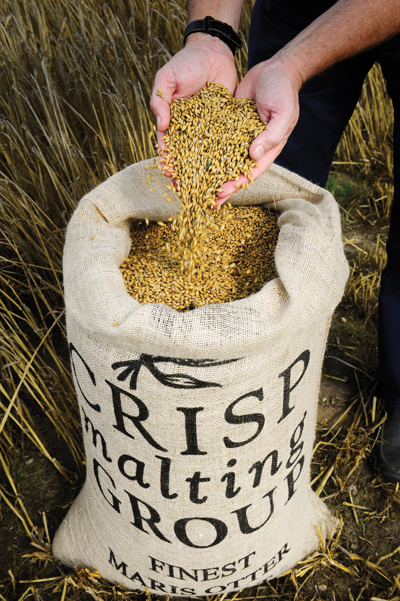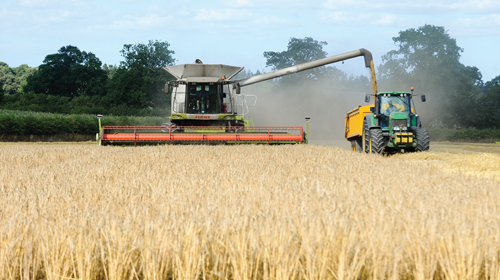
Malt. It’s the biggest ingredient by volume used in making beer except for water, yet it seems to be the least appreciated. Craft beer lovers fawn over hop varieties and their combinations in beers. Among brewers, yeast geeks abound. Fruits and spices and other flavoring agents like herbs or coffee delight many. Can’t malted grains get some love?
When you trace this ingredient back to its source, you see that it’s very much a part of the craft beer ethos. Farmers grow the barley, wheat, rye or other grain. There are, of course, small economies surrounding farming. And then there is the actual malting process, which is a craft of its own. At the Craft Brewers Conference in Denver earlier this year, we spoke with Euan Macpherson and Steve LePoidevin of Crisp Malting Group about this essential ingredient.
Crisp is one of the world’s most respected malting companies, having produced malt since 1870 to particularly high standards. It is the only privately held malting company in Scotland and England, the areas from which it sources its barley and other grains for malting. One of its five malting facilities also hosts one of the few remaining traditional floor malting plants in the world, giving them an intimate connection to their heritage and the centuries-old craft of malting. Most breweries in Japan probably use Crisp malt to some degree, but few consumers know much about the company or the process.
First the basics: during brewing, yeast gobbles up sugars to create alcohol and CO2 in beer. Those sugars come from the malt. Malting is a key step in unlocking those sugars. Ah, if it were really that simple…
In nature, when barley seeds sprout, released enzymes convert the starches into sugars for growth. Malting sort of recreates this process, but halts the conversion. Steeping is the first step. The grains are allowed to germinate in carefully controlled wet phases, where they are submerged in water, and dry phases, where they are allowed to breathe. After the root begins to emerge, the steeped barley is moved to germination vessels where malting companies control temperature and the flow of moist air. This is when the enzymes kick in, unlocking the starch. Kilning is the final step. To halt the germination so those valuable nutrients that brewers want are not used up in root growth, the “green malt” is dried down. This is a very delicate step because malting companies do not want to damage the enzymes that are key to the first stages of brewing. Kilning time and temperature influences the color and flavor of the malt that in turn affects the eventual color and flavor of the beer.
Crisp, like other great malting companies, combines the centuries-old craft of kilning with some very advanced science. Also, barley and other grains are living organisms affected by many variables, most notably weather. Each year’s crop is different and the malt undergoes detailed analysis. Crisp works to maintain consistency as much as possible through their collective of farms spread out in different regions. Most are in the southeast, but the company can turn elsewhere if necessary.
Steve and Euan note, “Three years ago, we had a drought. Sometimes we have uneven growth and high nitrogen. But our collective is big enough that we can sort problems out and give all brewers the same malt. We also have an insurance policy, of sorts, built in so that if some barley does not meet our quality standards, we can trace that barley back to its source (farm) and remove it from our supply. Thankfully, we’ve never had to do that, but that is in place to ensure quality just in case.”
Crisp also cooperates in developing sustainable farming and new kinds of barley. They were also involved in the revival of a once great barley variety, Chevallier. Popular in Victorian England, it gradually disappeared from cultivation as modern farmers turned to other varieties. Using seeds from a seed bank, scientists at the John Innes Centre decided to regrow some as a part of a project to reevaluate lost varieties. While they knew from historical records that it had good yield, they also discovered that it has strong resistance to a disease that is an issue in the malting industry today. Now, they are looking to cross-breed this with other modern varieties.
After growing a half an acre of the barley last year—the first time in over a hundred years—the research facility worked with Crisp’s floor-malting facility in Great Ryburgh, thereafter giving the malt to Stumptail Brewery to make bitter ale. The fascinating project is no doubt not the last of its kind. It proves the value of science to brewing, especially when combined with traditional practices like agriculture and malting. And it also proves the pre-industrial brewers using this revived variety knew exactly what the hell they were doing.


This article was published in Japan Beer Times # () and is among the limited content available online. Order your copy through our online shop or download the digital version from the iTunes store to access the full contents of this issue.



